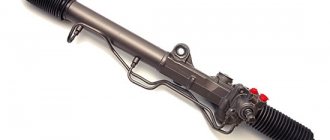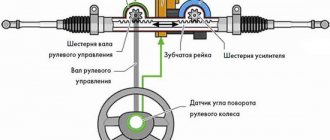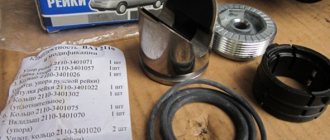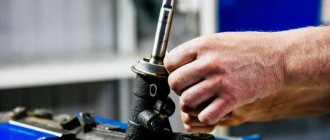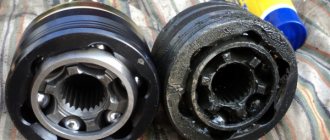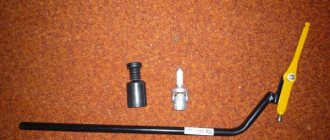Replacing the tie rod ends, sooner or later, is carried out on all cars. No matter how complex the steering system is on different car models, tie rod ends are present everywhere. But their number can be different - from 4 to 6 pieces.
The absence of this unit would lead to the loss of the meaning of having the entire steering control of the car, since only the tie rod ends can transmit the translational force transmitted through the mechanisms at a certain angle.
The transmission of translational motion at an angle is provided by special moving elements that use the principles of a hinge joint in their work.
Before replacing the tie rod end, it would be a good idea to understand its structure.
Service life of tie rod ends
Despite the importance of tie rod ends as a part, their service life is very limited. Tips are not a technically complex part, but this does not reduce their importance in the steering of a car. The approximate service life for which the tips are designed is 10 times less compared to the same engine, and reaches 30,000 - 40,000 kilometers. At this point, many car enthusiasts may object, saying that according to the regulations, the tips are changed less often - on runs of 50,000 - 60,000 kilometers. And they will be right, but only partly.
The harsh reality and domestic roads literally leave a certain imprint on the car’s suspension. Poor quality road surfaces, high humidity, dust, dirt, chemicals - all this greatly affects the condition of the suspension and steering components. And the tips in this situation are no exception, so the problem of their breakdown on runs from 20,000 to 30,000 kilometers is quite common for many advanced car enthusiasts.
Elimination of parts deformation
When bending any element, there are two ways:
- It is trivial to take and cut it in half and thus create freedom of action for yourself. A radical method, of course, but you should understand that parts with defects should be replaced in any case, because this greatly affects your safety.
- Heating a part to deform it to its original position. With this method, you still need to understand that you need to do everything carefully, because you don’t want to damage parts that are in good condition or remove the paint from the car under the influence of high temperatures. After this, it is also still worth replacing the part, since it will no longer perform all its functions and may behave extremely unpredictably.
Diagnosis of faulty steering tips
Diagnosing tie rod ends is quite simple; you only need a few tools, such as a jack and a wheel wrench.
First of all, you will need to jack up the car on one of the sides where the tips will be checked. After the car wheel is hung, it can be removed (optional) in order to facilitate the procedure for inspecting the tips.
To check the tips and tie rods, set the wheels straight and apply force to the pre-hung wheel at points “3” and “9” (just like on a clock), as if rocking the wheel in each direction. Moreover, from the inside of the wheel, with your free hand it is necessary to hold the steering tip at the place of its attachment to the steering knuckle.
If play is detected during this check, the tip is worn out and will need to be replaced. However, if no play is observed, then we repeat the checking process, but this time with our free hand we control not the steering tip itself, but the lower ball joint. With such a check, parasitic backlash should definitely appear.
When are tips changed?
During operation, the ball joints of the tips wear out quite heavily. This is especially true when regularly traveling on bad roads. Signs of wear are knocking noises when driving over uneven surfaces and the car yawping along the road. When such phenomena occur, you need to drive the car into the inspection hole. Tips are checked in two ways:
- One person turns the steering wheel, the other, from below, looks for the source of the knock;
- Using a pry bar, check the hinge for play.
If you notice any of the signs of a malfunction, you should replace the part.
But the dismantling of tips is not always associated with their malfunction. Often, they have to be removed in connection with the replacement of some of the associated parts. On some models, for example, to replace the wheel bearing, you need to remove the entire steering knuckle. The lever is also removed if it is necessary to repair the steering rack or gearbox. In any case, you will have to remove it very carefully so as not to damage the thread.
This is interesting: Where is the camshaft position sensor on Priora
The process of replacing tie rod ends. Introduction and instruments
It is necessary to approach the work of replacing steering tips responsibly, because driving with faulty tips can lead to dire consequences. You should also pay attention to the attachment of the tips themselves to the steering knuckles.
There are two types of attachment of tips to steering knuckles:
- installed with the pin down into the steering knuckle - closed type (with a closed outer casing and no nut on top);
- installed with a pin on top - open type (with an outer casing equipped with fixing nuts).
Depending on what type of tips are installed on the car, the set of necessary tools will also vary. So, for closed-type tips installed with the pin down into the steering knuckle, you will need a special puller, using which the tip can be easily “squeezed” out of the steering knuckle. Some craftsmen do without a puller, using a hammer, but it is better to refrain from such manipulations.
So, to replace the work you will need the following set of tools:
- jack;
- wheel wrench;
- a set of open-end wrenches and socket heads;
- WD-40 or other similar lubricant;
- brush;
- puller (for closed type tips);
- hammer (just in case).
Device
Essential elements:
- Insert made of Teflon;
- Ball pin with threads cut on it;
- Housing with lid;
- Anther;
- Finger nut.
Over time, wear of the Teflon liners leads to increased play in the steering rods, which means the car's controllability decreases, and this, in turn, affects driving safety.
Therefore, it is necessary at least once every 10–50 thousand km. mileage (depending on what roads you drive), carry out diagnostics of the steering and, if play is detected in the tip, urgently take measures that include completely replacing it.
Also, such work is carried out when rust appears on the parts of the tips and when the pin is bent, which can be formed as a result of a powerful, unpleasant for the driver, impact of the wheel on an obstacle.
Puller directly for ball joints.
Used for cars (Citroen, Peugeot) whose ball joint is screwed into the lever. And since it is screwed in and not pressed in, it is impractical to use the above tool options; you need a special puller, which we suggest you make from an 8-centimeter thick metal pipe for 2”.
- At one of the ends of this pipe, equidistant from each other, using a grinder or a hacksaw, make 4 rectangular tenons 5x7 mm.
- At the second end, using the same tool, again, cut slots equidistant from each other to a depth of 3 cm so that you end up with 8 petals.
- Use a hammer to slightly bend these petals towards the center of the circle, thereby reducing its diameter.
- Take a 24mm nut and weld it to the narrowed side of the workpiece. The DIY ball joint remover is ready.
It’s simple to use: put it on the support so that the spikes fit into the existing grooves of the ball body, then use a 24mm wrench to turn the welded nut, thereby removing the suspension element you need.
Recommendations
Comments 70
Renault Logan, Sandero, Largus, Megan guys, there is help for you here
This is what the services most likely use to unscrew the rods
This is how we unscrew it
